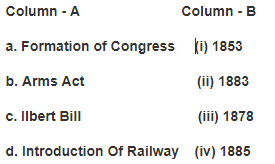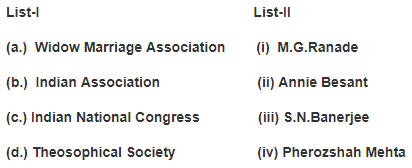Class 8 History Chapter 8 Practice Question Answers - The Making of National Movement : 1870s-1947
Q1. Read the following statements carefully which of the following is correct regarding Dada Bhai Naoroji-
(A) He was a businessman & publicist who settled in London
(B) He gave the popular “Theory of Drain Of wealth”
(C) He wrote The book “Poverty & Un-British Rule in India” in which he offered a scathing Criticism of the economic impact of British Life.
(D) All of These
 Dada Bhai Naoroji
Dada Bhai Naoroji
Q2. Match the following-

(A) a-iv, b-iii, c-ii, d-i
(B) a-iii, b-iv, c-i, d-ii
(C) a-ii, b-iv, c-i, d-iii
(D) a-i, b-ii, c-iii, d-iv
Q3. Read the following statements carefully -
(1) The INC was established when its 72 delegates met at Bombay in Dec.1885.
(2) The early leadership of Congress was in the hands of “Dadabhai Naoroji, Phirozshah Mehta, Badruddin Tyabji & W.C.Banerjee.
(3) The first women president of INC was Sarojini Naidu.
(4) A.O.Hume played an Important role in the formation of INC
Which of the above statements are true-
(A) 1, 2, 4
(B) 2, 3, 4
(C) 1, 2, 3
(D) 1,3, 4
Q4. Read the following statements carefully. Which one of the followings was not a demand of congress at its earliest times-
(A) It decided that British rule had led to poverty & famines.
(B) It demanded to reduce revenue, cut in military expenditure & more funds for irrigation.
(C) It demanded that Indians be placed in high position in the government.
(D) It demanded to reduce the age of ICS examination from to 21 to 19 & it would be held only in London.
Q5.
Assertion- British officials forced the Government to Withdrawal the Ilbert Bill-
Reason- The Bill provided for the trial of the British or European persons by Indians.
(A) Both (A) & (R) are Right is the right explanation of (A)
(B) Both (A) & (R) are Right but (R) is not the right explanation of (A)
(C) (A) is right but (R) is not Right
(D) (A) is wrong but (R) is Right
Q6. Which of the following is not correctly Matched-
(A) Motilal Nehru- Nehru Report
(B) Jinnah- Khilafat Movement
(C) Gandhi - Champaran Satyagrah
(D) Subhash Bose- Forward Block
Q7.
Assertion- B.K.Dutt and Bhagat Singh threw a bomb in the Central Legislative Assembly on April 8,1929
Reason- They wanted to protest against the passage of the Public Service Safety Bill Which would have reduced civil liberties.
(A) Both (A) & (R) and (R) is the right explanation of (A)
(B) Both (A) & (R) are Right but (R) is not the right explanation of (A)
(C) (A) is right but (R) is not Right
(D) (A) is wrong but (R) is Right
Q8. Which one is correctly matched-
(A) Do or Die – J.L.Nehru
(B) Swaraj is my Birthright – M.K.Gandhi
(C) Give me blood I will give you freedom – SC Bose
(D) Independence should be through Non- violence – Bal Gangadhar Tilak
Q9. Which one of the following is not correctly matched-
(A) Holt Mackenzie - Mahalwari System
(B) Lord Cornwallis - Subsidiary System
(C) Lord Rippon - Local Self Goverment
(D) Thomas Munro -Ryotwari System
Q10. What is common among Madam Bhikaji Cama, Barkatulla, V.V.S. Iyer & M.N.Roy?
(A) All of them were leading members of the International Communist Movement.
(B) M.Barkatullah was the Prime-Minister and the rest were the ministers in the provisional Government of Free India established by the group of revolutionaries at Kabul.
(C) All of them were among the prominent revolutionaries outside India operating in different countries during the freedom Movement.
(D) All of them were accused in the case relating to the throwing of the Bomb on Lord Hardinge.
Q11. Match List -I and List-II and select the correct answer by using the codes given below the lists-

(A) a-i, b-iii, c-iv, d-ii
(B) a-ii, b-iii, c-iv, d-i
(C) a-iv, b-ii, c-i, d-iii
(D) a-iii, b-iv, c-ii, d-i
Q12. The Indian National Congress agreed in 1947 to the partition of the country mainly because-
(A) The principle of Two Nation theory was then acceptable to them.
(B) It was imposed by the British Government and the congress was helpless in this regard .
(C) They wanted to avoid large scale communal riots.
(D) India would have otherwise lost the opportunity to attain freedom.
Q13. Which of the following pairs are correctly matched-
1. Theodore Beck - Mohammadan Anglo Oriental College, Aligarh
2. Ilbert Bill - Ripon
3. Pherozshah Mehta - Indian National Congress
4. Badruddin Tyabji - Muslim League
Select the correct answer using the codes given below-
(A) 1, 2, 3 & 4
(B) 1, 2, & 4
(C) 2, & 4
(D) 1, 2, & 3
Q14. Which of the following was not a feature of “Permanent Settlement System”
(A) Zamindars were made the legal proprietors of the land.
(B) Most of the landlords did not take any interest in the improvement of land.
(C) State was assured of the income
(D) One-Sixth of the produce was given to the government.
15. Match List-I and List-II and select the correct answer by using the codes given below the lists-
List-I(Events) | List-II(Results) |
a. Morley-Minto Reforms | (i) Country Wide agitation |
b. Simon commission | (ii) Withdrawl of movement |
c. The Chauri-Chura incident | (iii) Communal Electorates |
d. The Dandi March | (iv) Communal Outbraeks |
| (v) Illegal Manufacture of salt |
(A) a-i, b-iii, c-iv, d-v
(B) a-ii, b-iii, c-iv, d-i
(C) a-iv, b-v, c-i, d-iii
(D) a-iii, b-i, c-ii, d-v
Q16. Match List-I and List- II and select the correct answer

Codes:
(A) a-ii, b-iii, c-iv, d-i
(B) a-i, b-iii, c-iv, d-ii
(C) a-iv, b-ii, c-i, d-iii
(D) a-iii, b-iv, c-ii, d-i
Q17. Match List-I & List -II and select the correct answer using the codes given below the lists-
List-I | List-II |
a. Warren Hestings | (i) Anglo-Burmese War |
b. Cornwallis | (ii) Battle of Plassey |
c. William Bentick | (iii) The Charter Act of 1813 |
d. Ambert | (iv) Abolition of Sati System |
| (v) Regulating Act |
(A) a-i, b-iii, c-iv, d-v
(B) a-ii, b-iii, c-iv, d-i
(C) a-v, b-iii, c-iv, d-i
(D) a-iii, b-i, c-ii, d-v
18. The advocates appointed by the Indian National Congress to take up the case of the INA officers Shah Nawaz Khan, Dhillon and Saigal at the historic Red Fort at Delhi were-
(A) Bhulabhi Desai, Asaf Ali and Jawaharlal Nehru
(B) Jawaharlal Nehru, M.A.Jinnah and Sarat Chandra Bose
(C) Asaf Ali, Bhulabhai Desai and Rajgopalchari
(D) Rajagopalchari, Sardar Patel and feroz Gandhi
19. Match List-I and List-II and select the correct answer using the codes given below the lists-
List-I(Organisation) | List-II(Founder) |
a. All India Harijan Sangh | (i) Khan Abdul Gaffar Khan |
b. Congress Khilafat Swaraj Party | (ii) Raja Ram Mohan Roy |
c. Khudai Khidmatgars | (iii) Dadabhai Nauroji |
d. Brahmo Samaj | (iv) Motilal Nehru |
| (v) Mahatma Gandhi |
(A) a-i, b-iii, c-iv, d-v
(B) a-ii, b-iii, c-iv, d-i
(C) a-v, b-iv, c-i, d-ii
(D) a-iii, b-i, c-ii, d-v
Q20. Which of the following defines extremist ideology during the early phase of Indian Freedom Movement-
(A) Stimulating the production of Indigenous articles by giving them preference over imported commodities.
(B) Obtaining self-government by aggressive means in place of petition and constitutional ways.
(C) Providing national education according to the requirement of the country.
(D) Organising coups against the British Empire Through Military revolt.
Q21. Which one of the following groups of NewsPapers supported the cause of Indian Nationalism-
(A) The Kesari, Amrita Bazar Patrika, The Bombay Chronicle.
(B) The Daily Gazettee, The justice, the Madras Times
(C) The Delhi Mail, The Madras Mail, The Gujarati Punch.
(D) The Pioneer, Saiphul Islam, The Statesman.
Q22. Which Of the Following movements Acts of British Parliament was introduced to remove the shortcomings of the Regulating Act-
(A) Pitt’s India Act, 1784
(B) Charter act of 1793
(C) Government of India Act, 1919
(D) Rowlatt Act
ANSWERS -
Q.1.(D), Q.2.(A),Q.3.(A),Q.4.(D),Q.5.(A),
Q.6.(B),Q.7.(A),Q.8.(C),Q.9.(B),Q.10.(C),
Q.11.(A),Q.12.(C),Q.13.(D),Q.14.(D),Q.15.(D),
Q.16.(B),Q.17.(C),Q.18.(A),Q.19.(C),Q.20.(B),Q.21.(A),Q.22.(A),
|
65 videos|424 docs|46 tests
|
FAQs on Class 8 History Chapter 8 Practice Question Answers - The Making of National Movement : 1870s-1947
| 1. What is the national movement of India? |  |
| 2. Who were the leaders of the Indian national movement? |  |
| 3. What were the main methods of protest used by the Indian national movement? |  |
| 4. How did the Indian national movement impact India's independence? |  |
| 5. What were the significant events that marked the Indian national movement? |  |



















